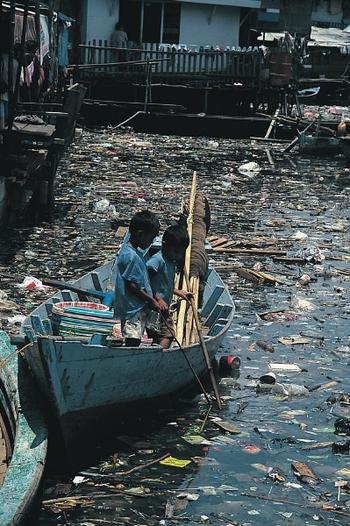Water quality and quantity
Integrated Watershed Management is addressing both water quantity and quality.
Water pollution: too dirty water
Image Credit: Stephen Codrington http://commons.wikimedia.org/wiki/File:Obvious_water_pollution.jpeg
Too dirty water occurs almost everywhere in non-developed countries and in countries with weak governmental structures and little awareness about the environment. Water pollution comes from irregular solid waste disposal, from human and animal faeces, from water source pollution, e.g. discharge of wastewater from industry and towns, from spraying herbicides and pesticides, etc.
Polluted water is the main trigger for water born (diarrhoea, etc.) and vector born (Malaria, etc.) diseases dominantly affecting rural and urban poor.
IWM is addressing also water / environmental pollution by awareness creation measures, but also by installation of waste collection systems or resettling of PIT latrines. However, the aspect of waste disposal, waste water treatment and environmental pollution has manifold and complex aspects and thus need specialists for individual and complex problem solutions. IWM is addressing the issue, but cannot solve these problems directly.
Protections of water sources against any kind of pollution are underlying manifold challenges. The figure above is high lightening only four water source problems, which lead direct or indirect to water pollution (next to pollution through waste disposal, sewage disposal and chemical pollution):
- polluted river water from upstream water consumers are directly affecting downstream water users
- overexploiting groundwater consumption leads to water shortage and contamination of water due to concentrations of pollutants of little water left
- pollution of shallow wells triggers water born deceases
- water allocation problems can lead to armed conflicts and consequently water source protections will be neglected.
Water pollution is not only a challenge for surface water, but also for groundwater. Groundwater seems to be less affected by pollution, since polluted water is filtered by soil and bedrock through its way of percolation. Deep groundwater is therefore underlying less pollution than shallow groundwater. However, it is matter of time to pollute also deep groundwater.



